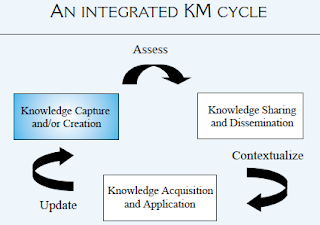Which is hard to capture the tacit knowledge because this is a process to capture the experience, the expertise of individuals within the organization and provide for anyone who membutuhkannya.Tacit will remain tacit until there are any questions to be explicit. Capture explicit knowledge is a systematic approach to capture, organizing and refining the information to be easily found and used for learning and problem solving. Capture knowledge can be done at the level of individuals and groups within the organization.
TACIT KNOWLEDGE CAPTURE
In Knowledge Management, knowledge creation or capture can be done by individuals working for the organization or the group that are within the organization, by any member of the community of practice (CoP). This can be done on a personal level, to allow any personal activity knowledge creation, capture, and Codification brand outside of work. Cope (2000) classifies it as personalized Knowledge Management. A number of techniques that can be used to capture tacit knowledge of individuals and groups
- Ad hoc sessions.
- Road maps.
- Learning histories.
- Action learning.
- E-learning.
- Learning from business guest speakers and benchmarking with best practices back.
EXPLICIT KNOWLEDGE CODIFICATION
Knowledge can be shared through personal communication and interaction, as we learned in the first quadrant, socialization, from Nonaka and Takeuchi models Knowledge Management. There are four important concepts that represent Codification Knowledge Explicit:
- Cognitive or concept map
- decision tree
- Manual knowledge taxonomy
- Automated knowledge taxonomy


Conversion Conversion Emoticon Emoticon